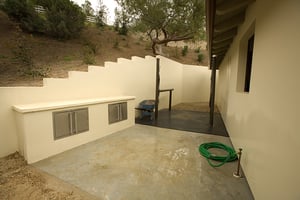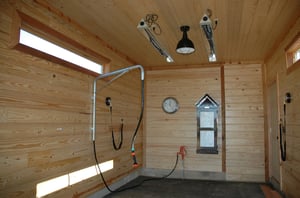Call us today (800) 444-7430
Call us today (800) 444-7430
 They can be used for many other tasks as well – grooming, tacking up, shoeing and vet visits. One of the main things you’ll need for your wash bay is access to water. While cold water is often sufficient in some parts of the country, installing a tankless water heater for instant hot water will make your barn a big favorite with anyone who boards there. There is nothing that says that a wash bay must be inside the barn. In fact, in places with mild winters, most bathing is done with an outside wash rack.
They can be used for many other tasks as well – grooming, tacking up, shoeing and vet visits. One of the main things you’ll need for your wash bay is access to water. While cold water is often sufficient in some parts of the country, installing a tankless water heater for instant hot water will make your barn a big favorite with anyone who boards there. There is nothing that says that a wash bay must be inside the barn. In fact, in places with mild winters, most bathing is done with an outside wash rack. A non-slip floor with a drain is an absolute necessity. If you are making a wash rack outdoors, this can easily be done by putting several layers of crushed gravel down and allow the water to simply seep down through the layers and away. However, for an indoor wash bay, there are more options. While concrete is most often used, it is hard on a horse’s legs and can become slippery when wet. Interlocking button mats are a good option when it comes to wash bay flooring. Their button style design provides excellent traction, and along with being completely nonabsorbent, they will not harbor or promote bacterial growth.
A non-slip floor with a drain is an absolute necessity. If you are making a wash rack outdoors, this can easily be done by putting several layers of crushed gravel down and allow the water to simply seep down through the layers and away. However, for an indoor wash bay, there are more options. While concrete is most often used, it is hard on a horse’s legs and can become slippery when wet. Interlocking button mats are a good option when it comes to wash bay flooring. Their button style design provides excellent traction, and along with being completely nonabsorbent, they will not harbor or promote bacterial growth.  bay. Infrared heaters can be added to help take the chill off a wet horse in cool conditions. While heaters work best when installed directly over where the horse will be standing, lights should be installed on either side of the stall ceiling or on the side walls to prevent shadows that could spook a horse. Add shelves or cabinets for common grooming supplies like brushes and shampoo and/or medical supplies. Look for cabinets made of plastic or metal – wood or laminate can fall apart too easily.
bay. Infrared heaters can be added to help take the chill off a wet horse in cool conditions. While heaters work best when installed directly over where the horse will be standing, lights should be installed on either side of the stall ceiling or on the side walls to prevent shadows that could spook a horse. Add shelves or cabinets for common grooming supplies like brushes and shampoo and/or medical supplies. Look for cabinets made of plastic or metal – wood or laminate can fall apart too easily.

From horse stalls to barn doors, stable flooring and entrance gates, Classic offers the widest product lines in the industry while continuing to expand through innovation and strategic alliances.
We look forward to answering your questions. Our sales team is knowledgeable about everything from horse barn design to equine stall systems and readily available to assist you in planning your Classic barn!
ph: (800) 444-7430
em: sales@classic-equine.com
